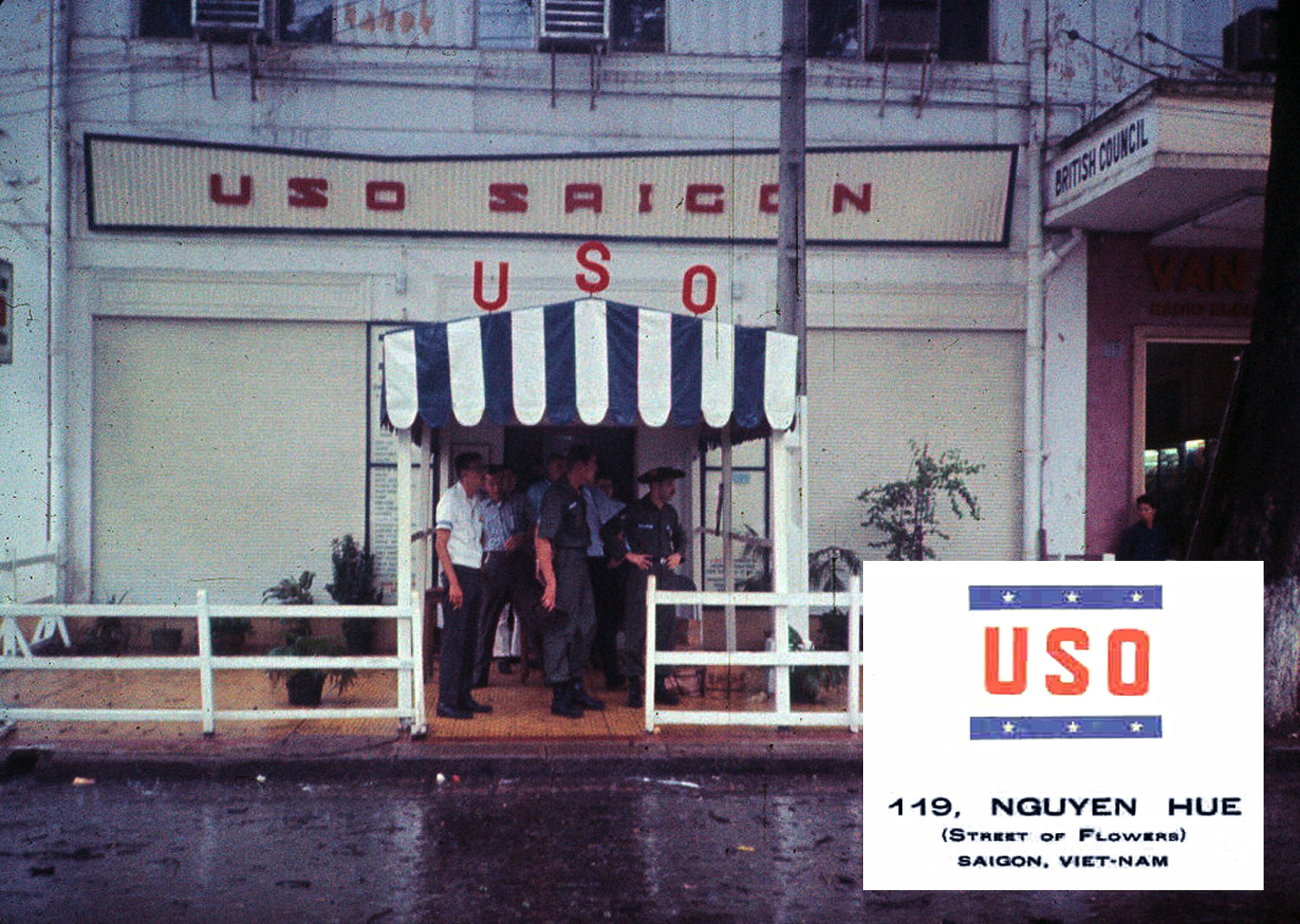
The USO Club of Saigon in 1965 by Bruce Baumler
In 1963, the USO Club of Saigon issued a leaflet promoting its services and suggesting the following tourist itinerary around the city for US military personnel and their dependents.
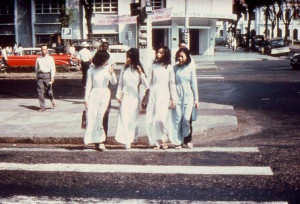
Lê Lợi boulevard in 1964, photographer unknown
The newcomer to Saigon is often agog with the myriad of signs on all sides of him, brightly painted in a multitude of colors, proclaiming the fascinating sights to be seen here; the countless shops, row upon row, pressed in so closely together; and here and there, unexpectedly, a truly unusual temple or a very modern building can be seen among the great masses of people hurrying along Saigon’s busy streets.
In an effort to give a little aid to the military personnel and their dependents who are interested in visiting as many of these places as their time allows, the USO has compiled a list of the locations and other available information concerning the most popular points of interest.
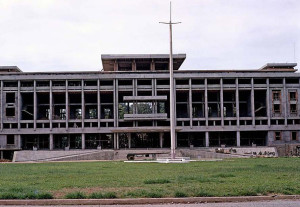
“Construction of new government building in 1963,” photographer unknown
Perhaps you might start your tour by driving or walking by the Independence Palace, which, until November 11 1962, was the residence of President Ngo-Dinh-Diem. This once beautiful palace is now in the process of being completely rebuilt after a bombing destroyed it. It is expected that it will be finished and ready for President Diem’s occupancy in 1964.
How about a ride in one of the city’s many cyclos? It is an exciting experience and the next stop on our tour might be Our Lady’s Basilica in Hoa-Binh Square, one of the oldest buildings in Saigon. Mass is said here in French and Vietnamese. Everyone is welcome to this lovely old church.

Saigon Post Office in 1960, photographer unknown
As we swing around the square, we notice on our left the large clock on the PTT Building (Post Telegrams and Telephones). The commercial post office is located here and all postal services are available. It is also possible to place long distance calls from here. The PTT building is open from 7.30am until 8pm. This includes Holidays but not Sundays.
Continuing down Tu Do Street, we are headed toward the river. On our left we pass a large white building which is the National Assembly Building. No one is allowed to visit unless they have been given special permission to go on official business. Here the government has a meeting hall and offices for the various government officials. Policemen in white uniforms guard this building days and night.
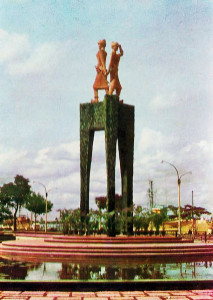
Saigon – the Trung Sisters statue, photographer unknown
If we cut over a block to the left, we will be on Hai Ba Trung, and turning right, headed for the river front. Right in front of us is the Memorial to the Trung Sisters. These ladies were the heroines of the Vietnamese Struggle for Independence in 40AD. If you look very closely, we’ve been told that you will see a strong resemblance between the Trung Sisters’ faces and Madame Nhu, the President’s sister-in-law, and the first lady of the Republic of Viet-Nam!
Along this river, which joins the China Sea and has piers for loading and unloading ships for long-range or short-range trips, there are many interesting sights.
Time for lunch? There are many restaurants featuring French and Chinese as well as Vietnamese foods located all over the city, and one can have fun just trying them out, as they have good food and lots of local color. But at the USO, a good old American sandwich and a milk shake tastes pretty good too!
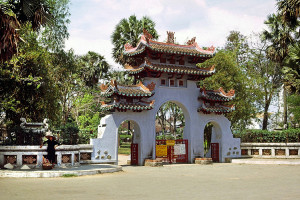
Lê Văn Duyệt Mausoleum, photographer unknown
In this fascinating city of the Far East, the old temples and pagodas are especially interesting to someone from the western world. One such temple is the Tomb of Marshal Le-Van-Duyet, military hero under the Gia-Long dynasty. He was called the Unifier of Viet-Nam in the 19th Century. It is a very impressive place to visit, and also noteworthy that if you can get a little assistance from a Vietnamese person, you can have your fortune told right here! This temple is located all the way out Hai Ba Trung, where it intersects with Chi Lang.
There are other Buddhist temples and pagodas throughout the city. The Xa-Loi Temple is located at Ba Huyen Thanh Quan Street. Here, a statue of Buddha can be seen in a golden case which came all the way from India.
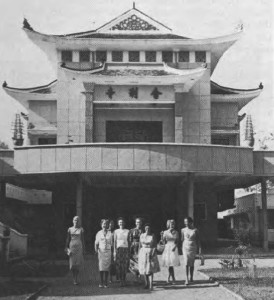
“American girls say goodbye to the beautiful Xa Loi Pagoda,” from the US Pocket Guide, 1962
By the way, a Temple is where Buddhists worship many heroes and heroines but a Pagoda is where many men worship Buddha. There is a Hindu Temple at Ton That Thiep Street, and this the meeting place for the thousands of people from India who own many of the city’s shops. Visitors are welcome here too, but it is customary to remove your shoes before entering.
There are so many other Temples and Pagodas that they are too numerous to mention here, but a little investigating will be all you need to find a different experience in store for you, in quite a few of them.
The National Museum and War Memorial Monument are located at Thong Nhat. The Zoo and Botanical Gardens are also here. The grounds are open every day and admission is 2$ for adults and 1$ for children (except on Thursdays when the admission is free).
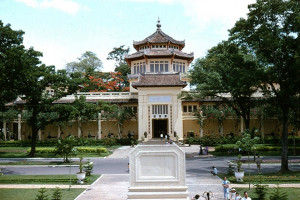
The National Museum in 1965 by Robert Gauthier
In the National Museum there are many exhibits of Vietnamese pottery and the costumes of ancient Kings. Some examples of traditional Vietnamese furniture are on display, along with the cut crystal vase presented to President Diem by our Past-President, Eisenhower.
In the Zoo and Botanical Gardens there are several unusual species of birds and animals, as well as an elephant which will pray for you if you give him a piece of sugar cane.
If we go out Le Loi Street, we will pass the Central Market of Saigon, and we must stop for a while and visit the multitude of tiny stalls, where all kinds of beautiful material can be purchased, as well as many, many other items, such as the lovely lacquerware of Viet-Nam, and anything else you may need, from food to the pots in which to cook it.
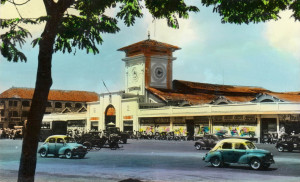
The Saigon Cemtral Market, photographer unknown
The merchants speak French or Vietnamese, but don’t let it stop you if you do not speak these languages! Just take along a pencil and paper and show that you want them to write down the price for you, and they will find someone to do that. Then, let’s see how good a bargainer you are!
If we continue in this direction, the street will become Tran Hung-Dao and we will be on our way to Cholon, the Chinese section of Saigon. Here, the shops are very numerous, and there is another large market. Cholon has many excellent restaurants, also. At night, the visitor is treated to a bright display of neon signs almost rivalling the cities in the United States.
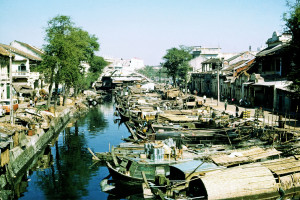
A side canal off the Ben Nghe Creek, in 1965 by Thomas W Johnson.
Since our space is limited here, we will end the tour in Cholon (just take one of the hundreds of tiny taxis back to the center of the city). However, there are many more interesting things to see in this unusual place and we, at the USO, will be more than happy to supply the information you may need in locating these places, or we will find someone for you who can! Be sure to stop in often to see us and say “Hi” (we all speak English!).
Located at 119 Nguyễn Huệ, the USO Club of Saigon was advertised as “a home away from home for American military personnel and associated civilians.” Run by a federation of six civilian agencies (YMCA, YWCA, Salvation Army, National Catholic Community Service, National Jewish Welfare Board and National Travelers’ Aid Association), the USO Club was “an overseas operation administered by USO, through which the American people serve the spiritual, welfare and educational needs of the men and women in the Armed Forces.” It was open every day from 9am to 11pm and contained an information and resource office for US servicemen, a restaurant, a bar and a games hall.
Tim Doling is the author of the guidebook Exploring Saigon-Chợ Lớn – Vanishing heritage of Hồ Chí Minh City (Nhà Xuất Bản Thế Giới, Hà Nội, 2019)
A full index of all Tim’s blog articles since November 2013 is now available here.
Join the Facebook group pages Saigon-Chợ Lớn Then & Now to see historic photographs juxtaposed with new ones taken in the same locations, and Đài Quan sát Di sản Sài Gòn – Saigon Heritage Observatory for up-to-date information on conservation issues in Saigon and Chợ Lớn.

